Artificial Intelligence Tutorial – It’s your time to innovate the future
Free Machine Learning courses with 130+ real-time projects Start Now!!
Have you ever thought what would our lives be like in a world without Artificial Intelligence? Or without computers? Recall how you spend an average day of your life- you get up, then you check your smartphone. You reach your workplace, and then start working over the internet.
Remember, most of your work takes place over cloud computing and other services the internet provides. Now picture that you have to look for an answer to something. For how long and in how many books are you going to keep searching for the answer?
Let’s take another example, you come back home and decide to order food online. Who really places the order if you are behind the screen? Before going to sleep, you probably use a voice to text assistant that’s present in your phone to set an alarm for the next day.
We can’t imagine living without all that now, can we?
What is Artificial Intelligence?
You might be thinking what exactly is artificial intelligence? One might say that it is the ability of computers to think and act like humans. In a very simple language, yes, it is just that. But there’s more to it. Let’s explore artificial intelligence in detail.
Artificial intelligence, as known as AI, is the imitation or cloning of human intelligence, that allows machines, more specifically computer systems, to perform in an extremely intelligent manner. What exactly does it do then?
So basically, an artificially intelligent system perceives its environment in a manner that helps its analytical self in maximizing its chances of success. John McCarthy coined the term in 1956 and was defined as the science and engineering of making intelligent machines.
It emphasizes on developing machines to think and work just like humans.
The Need for Artificial Intelligence
Why do we even need artificial intelligence? This question would have definitely arisen in your minds by now. Well, humans are a lazy species. We would love to live in a world where there is minimal human labour and thus we are able to save ample amounts of time.
Also, the data we are producing is in huge chunks. We as humans need something that processes and handles data to minimize the strenuous efforts being put into handling it. This processing and handling of data is called data science.
Data Science, in simple words, is the scientific study of data, that stores, records and analyses data for our benefit. Now AI brings in a new perspective towards managing problems and solving them.
Classification of Artificial Intelligence
There are two classifications of Artifical Intelligence-
- Weak AI or Narrow AI
- Strong AI or General AI
An AI can be strong or weak, depending upon the amount of tasks it can conduct. A Weak AI, also called Narrow AI, is a system that is designed to handle just one particular task. Speech recognition can serve as a good example of a weak AI.
The programming is such that it is only able to identify spoken words & phrases and convert them into a machine-readable format.
In contrast, we can apply a Strong AI or a General AI to accomplish a variety of tasks, as well as learning and improving itself. For example, AlphaGo is a computer programme that plays the board game Go.
It learns, and improvise itself according to situations arising in the game and has beaten Lee Sedol- a South Korean professional gamer. There is believed to be a third category, apart from Strong AI and Weak AI, Artificial Super Intelligence.
ASI refers to the time when the capabilities of computers would exceed that of humans- now this is the situation I was talking about in the beginning.
Now in this artificial intelligence tutorial, let’s learn about the types of AI.
Types of Artificial Intelligence
Arend Hintze, an assistant professor at the Michigan State University, classifies AI into four types:
- Reactive Machines
- Limited Memory
- Theory of Mind
- Self Awareness
1. Reactive Machines
Reactive machines do not store memories or learnings from past experiences. They simply react to the surroundings and choose the most optimal solution amongst available alternatives. It cannot infer from its prior experiences to build on.
We all remember IBM’s DeepBlue, a chess-playing supercomputer, which defeated international grandmaster Garry Kasparov.
DeepBlue is capable of identifying pieces on a chessboard and even can predict what could be the next move of its opponent.
It can also choose from the next possible moves, however, it is unable to retain any memory and bring past experiences into the picture while making decisions- which means that previous moves will not affect its future decisions.
2. Limited Memory
Limited memory machines retain data in a transient manner; meaning that its memory lasts for a short period of time, much like a goldfish, haha! Erm…shh, computers are more intelligent now! Let’s not make fun of them!
Coming back to the point, such a system can use experiences occurred in the recent past to inform future decisions.
However, it cannot add these ‘experiences’ to its database or library. For example – a self-driven car stores the speed and pattern of changing lanes, etc of cars around it, and navigates on the basis of this data. However, perpetual storage of these observations does not occur.
3. Theory of Mind
With theory of mind, we can say that it’s the type of AI that is yet to exist. The purpose behind building such an AI is to have computers that can simulate human emotions, beliefs, and desires, that impact future decisions.
It relates to the understanding of the world that other entities also have thoughts, memories, and feelings. For two individuals to be able to work together, they need to have some sort of interaction between them.
AI systems will interpret in the future that humans have expectations as to how they should be treated. Isn’t that great? Most computers today use various models to drive their behaviour, but one with a mind of its own is yet to exist.
Researchers are developing Bellhop Robot for hotels, which will predict the demands of people who intend to stay in the hotel.
4. Self-Awareness
What is all this meditation and spiritual stuff in the midst of artificial intelligence now? To answer that, let’s first understand self-awareness. When an individual has conscious knowledge of their character and their own feelings, he/she becomes self-aware.
An AI is self- aware when it is able to form representation about itself, and thus, be conscious about itself. A self- aware machine will understand its current state and use the information to infer the emotions of others.
AI researchers and enthusiasts believe that this can prove to be the ultimate goal of AI development. Once this is achieved, AI will operate like a human and start predicting its own needs and demands and start thinking of others as an equal.
Such an AI does not exist yet. Guess the only thing that won’t have feelings now is rocks then? Lol.
If you have any queries related to artificial intelligence tutorial till now, mention through comments.
Applications of Artificial Intelligence
AI, my friends, is not in the near future now. It is right here, right now. It is lurking behind your screens as you are reading this article, and will probably suggest you more such articles from now on.
Artificial Intelligence is not just limited to personal assistants or OTT platforms but is relevant to a number of aspects of our day-to-day lives.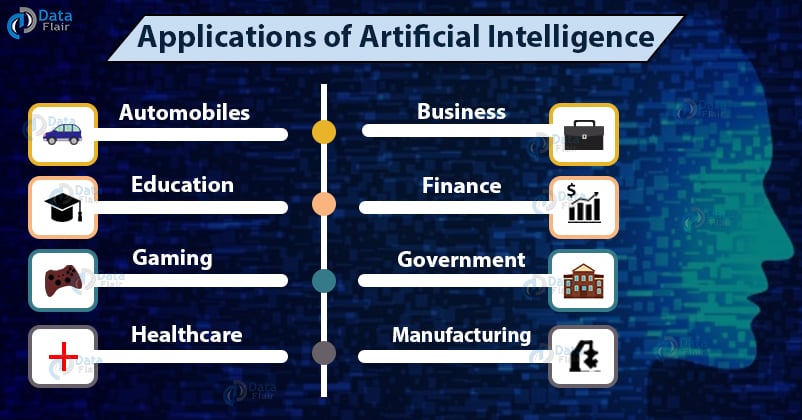
1. AI in Automobiles
AI is now advancing towards driverless cars. These cars have incorporated systems that are useful in applying brakes, changing lanes, navigation, and many more. Such cars interpret the pattern in which other cars are moving and try to imply that in themselves.
It is also being worked on in the insurance sector, which can help in fast and more efficient filing of claims and insurances.
2. AI in Business
A firm can use AI-based solutions by determining what are the weaknesses and strengths and use these solutions to deduce its financial, production-related and CRM and other objectives. It helps in automating tasks that in turn save an awful lot of time and man-power.
McDonald’s is one such example of AI being used in businesses, as it is focusing on elevating customer experience by analyzing trends in which a customer places order- like a hot plate of french fries on a cold winter evening, or an iced coffee on a hot summer afternoon.
It has also introduced kiosks or interactive terminals, where customers place orders over a machine by themselves, instead of a cashier making the inputs. This has proven to reduce errors and increase sales.
3. AI in Education
AI can deliver a better learning experience by adjusting learning as per the needs of each student, and provide universal access to students. It can also automate grading systems. AI can also provide additional support to the students, as required.
4. AI in Finance
Personal finance applications, as the name suggests, collect personal data and provide advice and suggestions related to the user’s finances. Such software even do most of the trading in stock markets.
5. AI in Gaming
AI generates alternatives in a video game on the basis of the decision we take in the game. These decisions include player movements, taking cover, pathfinding, etc. Video games like Minecraft, Tom Clancy’s Splinter Cell: Blacklist, etc use AI-based programming.
6. AI in Government
Governments have started honing AI to make suitable policies and services. Governments can use AI to counter natural disasters, road accidents, and many such problems a country may face.
With the aid of AI-based applications, developers are trying to bring about a change in the way the public sector works. Such apps can reduce costs and errors, save employees from mundane tasks and also help in clearing out backlogs.
7. AI in Healthcare
AI is proving to be extremely useful by assisting doctors and thus improving the recovery and mortality rate of the patients. Some AI applications include chatbots, which answer and assist patients to schedule appointments, aid in the billing procedure and also provide medical feedback.
8. AI in Manufacturing
A manufacturer can enhance its production quantity and quality by applying AI to forecast future demand and supply, production planning, material movement, assembling the parts, and all such activities involved in manufacturing.
9. AI in NLP
NLP, acronym for Natural Language Processing, deals with the ability of the computer to understand the natural language of its users. Spell check and autocorrect are two of the most commonly used NLPs. I have a habit of writing ‘Yasss brooo’ when I get excited about something.
My phone has understood this, and every time I am close to finish typing ‘yasss’, the keyboard of my smartphone immediately and automatically suggests ‘brooo’.
Benefits of Artificial Intelligence
Okay, so by now you must have understood that we are applying AI in multiple areas of our day-to-day lives, but is it any good? Does it really benefit us the way it is being portrayed to? The answer to that is a definite yes, but let’s understand the advantages more specifically:
1. Less Scope for Errors
First and foremost, with the advent of AI, machines have started to analyze trends more often. This helps them in, accurately guessing the need of the user. Also, as AI-enabled machines are responsible for inputting the values and data, this reduces the chances of human error.
For example – in an organization that relies heavily on the data that a human feeds to a system is likely to face more issues, as the chances of a human to be perfectly accurate at all times is not 100% .
So, a machine that analyses its surroundings and feeds data into itself accordingly proves to be more accurate.
2. Better decision making
The bias of our understanding affects most decisions that we humans take. No matter how much we try, our current mood, or thinking influences a percentage of the decision. In the case of AI-enabled systems, this proves to be entirely untrue.
As machines don’t yet have feelings of their own, or biases and interpretations of their own, we can be rest assured that decisions taken by systems are not influenced by personal prejudices.
3. Can Work in an Uninterrupted Manner
Artificially intelligent systems don’t feel tiresome after working continuously for large periods of time. Humans need some rest after working for a certain amount of time. We can’t keep working all day long, everyday without taking even one break. However, a machine keeps on working without getting tired.
4. Handle Complexities
It is not humanly possible to handle more than a particular number of tasks. We get confused and might mess up the way things are supposed to be. Machines come into rescue exactly when things go beyond the control of us humans.
Handling large amounts of complex data is just another function of such systems, apart from speedy day-to-day operations and improved data handling.
5. Optimum Utilization of Resources
AI systems can assess and interpret multiple things at one particular point of time. From handling employee database and customer database to analysing the patterns that these groups follow, there is a lot that just one machine can accomplish.
Whereas humans as well, can accomplish multiple types of tasks, but not all simultaneously.
Examples of Artificial Intelligence
Okay, okay. Now you must be wondering where exactly is AI used? I mean, self-driven cars and robots are one thing, but how about some current, real-time examples? So here are a few examples of AI in artificial intelligence tutorial –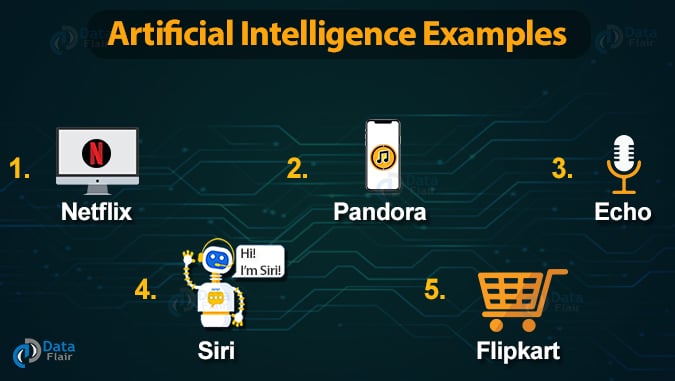
1. Netflix
Netflix is the top used OTT platform today. OTT platforms, an acronym for Over The Top platforms, are those service providers that provide content to viewers over the internet, most probably for a subscription fee.
These are also known as Other Than Television platforms, like Netflix, Amazon Prime, etc. Recently I finished watching Stranger things, a sci-fi fantasy horror web television series, revolving around school-going teenagers.
Just after that, Netflix started recommending me Typewriter, an Indian origin horror web series, in which some teenagers uncover a ghostly mystery.
2. Siri
How often do we hear this term- Hey Siri? Siri is a personal assistant offered by Apple for the users of iPhones and iPads. It is a voice-activated assistant that interacts with the user as per their convenience.
Siri uses machine learning technology to understand the way in which a user navigates through their phone, send messages and make calls. To use this feature, you just have to unlock your phone, activate the internet, and begin. ‘Hey Siri, call mom’, and immediately, Siri will place a call to your mom.
3. Pandora
Pandora is a platform that uses AI to assess which sort of music should be played for its user. It provides not so obvious song choices.
For example – if I look for a certain rock song, say Hey You by Pink Floyd, then Pandora might also suggest Stairway to Heaven by Led Zeppelin, which is another classic rock song.
4. Flipkart
Flipkart is an e-commerce shopping platform that suggests products to its customers on the basis of their history of product viewing or purchasing.
So one of my friends recently looked for a certain novel on Flipkart a few days ago, and now he’s been seeing it as a recommendation every time he visits Flipkart or any random website with commercial ad space.
5. Echo
Echo is a device launched by Amazon which has a cloud-based voice assistant, Alexa. It can hear, comprehend and respond to any commands or questions put up by the user with viable solutions.
I asked Alexa yesterday if I needed a raincoat before heading out, and it suggested me to take one as it was going to rain in the evening.
Now in this artificial intelligence tutorial, we will discuss the career opportunities available in AI.
Career in Artificial Intelligence
Isn’t it interesting? Building something that will build our future tomorrow? Anyone can pursue a career in AI, depending upon their qualifications. As vast as AI maybe, pursuing a career in this field has its own specifications.
You can pursue the following to build a career in AI:
1. Machine Learning Engineer
To become a machine learning engineer, you should have knowledge of computing, programming language like Python, statistics and software engineering. The initial salary would range from 7-8 lacs p.a.
2. Data Scientist
Data scientists possess technical skills to solve complex problems, with their knowledge of programming languages like Hadoop, SQL, Spark, Python, etc, machine learning, statistics, and communication. A fresher in data science would earn somewhere around 4.5 to 6 lacs p.a.
3. Business Intelligence Developer
As a business intelligence developer, you would design, model, and maintain complex data, as well as be able to communicate the terminologies related to AI to non-technical people as well. You can start earning as much as 5-9 lacs p.a. as a newbie.
4. Research Scientist
Research scientists are expected to be a Ph.D. or at least hold a master’s degree in computer sciences. The candidates must pursue good amount of knowledge of parallel computing, NLP, machine learning, and AI, to begin with.
The average salary of a fresher research scientist ranges between 6 lacs p.a. to as much as 16 lacs p.a.
5. Big Data Engineer/ Scientist
A big data engineer/ scientist creates as well as handles the infrastructure and tools, in order to get results from vast amounts of data.
You must have a fair knowledge of languages like C++, Java, Python, and Scala, along with experience in data mining, data migration, etc. The starting salary in such a profile would be 8-9 lacs p.a.
Summary
In the long term, Artificial Intelligence is going to be something that proves to be a technology that is as intriguing as it is frightful. It is frightening in the sense that it might trick us humans and all that we can imagine- might as well someday become a reality.
But at the same time, it also will enhance the capabilities and creativity of humankind. Or maybe one day, AI will take us through time and space, who knows! We just have to wait and watch how the tables turn.
Hope that this introduction gave you a better understanding of the technology that artificial intelligence is.
If you have any queries related to artificial intelligence tutorial, you can always reach out to us by dropping in your comments in the section below! We would love to respond to them.
You give me 15 seconds I promise you best tutorials
Please share your happy experience on Google
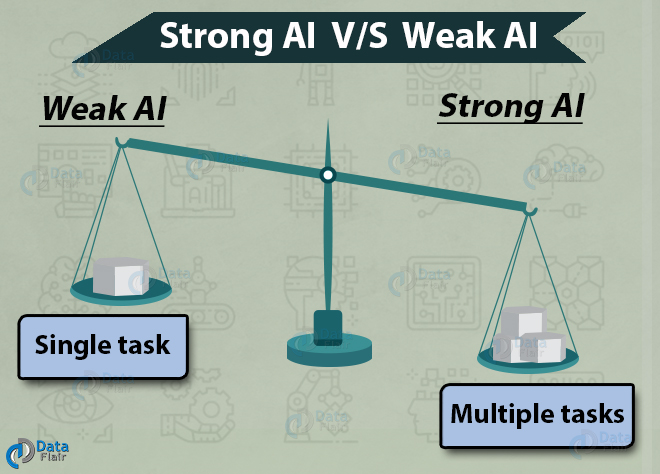
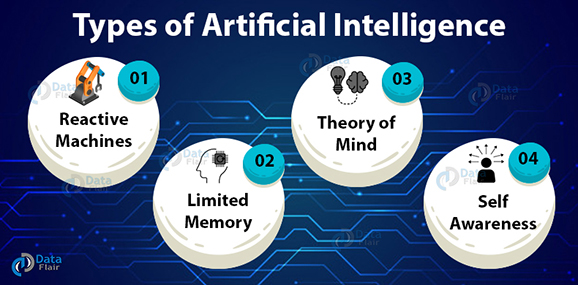
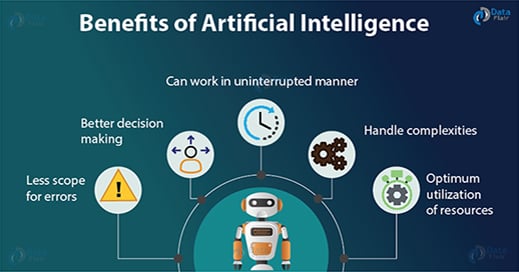


Nice
Full Course of Android App Or IOS App development
very good information about Artificial intelligence
who wrote this